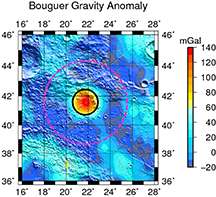Team puts Earhart on the moon with discovery of new crater

The discovery of a massive, 124-mile-wide crater on the moon was announced at the Lunar and Planetary Science Conference on Monday (March 16).
A team of researchers at Purdue University found the crater through an analysis of data from NASA's Gravity Recovery and Interior Laboratory, or GRAIL, mission, which captured an unprecedented, detailed map of the distribution of masses in the moon.
The team provisionally named the crater Earhart, after the famous aviator Amelia Earhart. Names of planetary features must be submitted and approved by The International Astronomical Union.
Although some of this crater is visible at the surface of the moon, most of it is buried and could only be seen through gravity signatures captured during the GRAIL mission, said Jay Melosh, a distinguished professor of earth, atmospheric and planetary sciences, who led the research.
"This is one of the biggest craters on the moon, but no one knew it was there," said Melosh, who also is a member of the GRAIL science team. "Craters are named after explorers or scientists, and Amelia Earhart had not yet received this honor. She attempted a flight around the world, and we thought she deserved to make it all the way to the moon for inspiring so many future explorers and astronauts."
The team was testing a new technique that sharpens the GRAIL data to see smaller-scale features, like ridges and valleys, when they noticed an unusual circular feature, said Rohan Sood, a graduate student in Purdue's School of Aeronautics and Astronautics who worked on the project and presented the findings.
"The feature turned out to be the rim of an ancient crater, but it was so big we did not even recognize it as that at first," Sood said. "We were zoomed in on one little piece of it. We first tried to model it as a small crater, but we had to go bigger and bigger and bigger to match what the data was telling us."
The finding validates the team's technique, and the group plans to extend the search to the entire moon to reveal other buried craters and small-scale features beneath the surface, Sood said. The search could uncover underground tunnels formed by lava flows, called lava tubes, which have been discussed as a possible shelter for human habitats on the moon.
In addition to Melosh and Sood, team members include Loic Chappaz, a graduate student in the School of Aeronautics and Astronautics; Kathleen Howell, Purdue's Hsu Lo Professor of Aeronatuical and Astronautical Engineering; Colleen Milbury, a postdoctoral research associate in the Department of Earth, Atmospheric and Planetary Sciences; and David Blair, a graduate student in the Department of Earth, Atmospheric and Planetary Sciences.
Earhart was a Purdue career counselor and adviser to the Department of Aeronautics from 1935-1937, and Purdue is home to the world's largest compilation of Earhart-related papers, memorabilia and artifacts. The collection includes documents related to Earhart's 1932 solo Atlantic flight, her second and fatal attempt at a world flight in 1937, and items related to her time at Purdue.
Provided by Purdue University




















